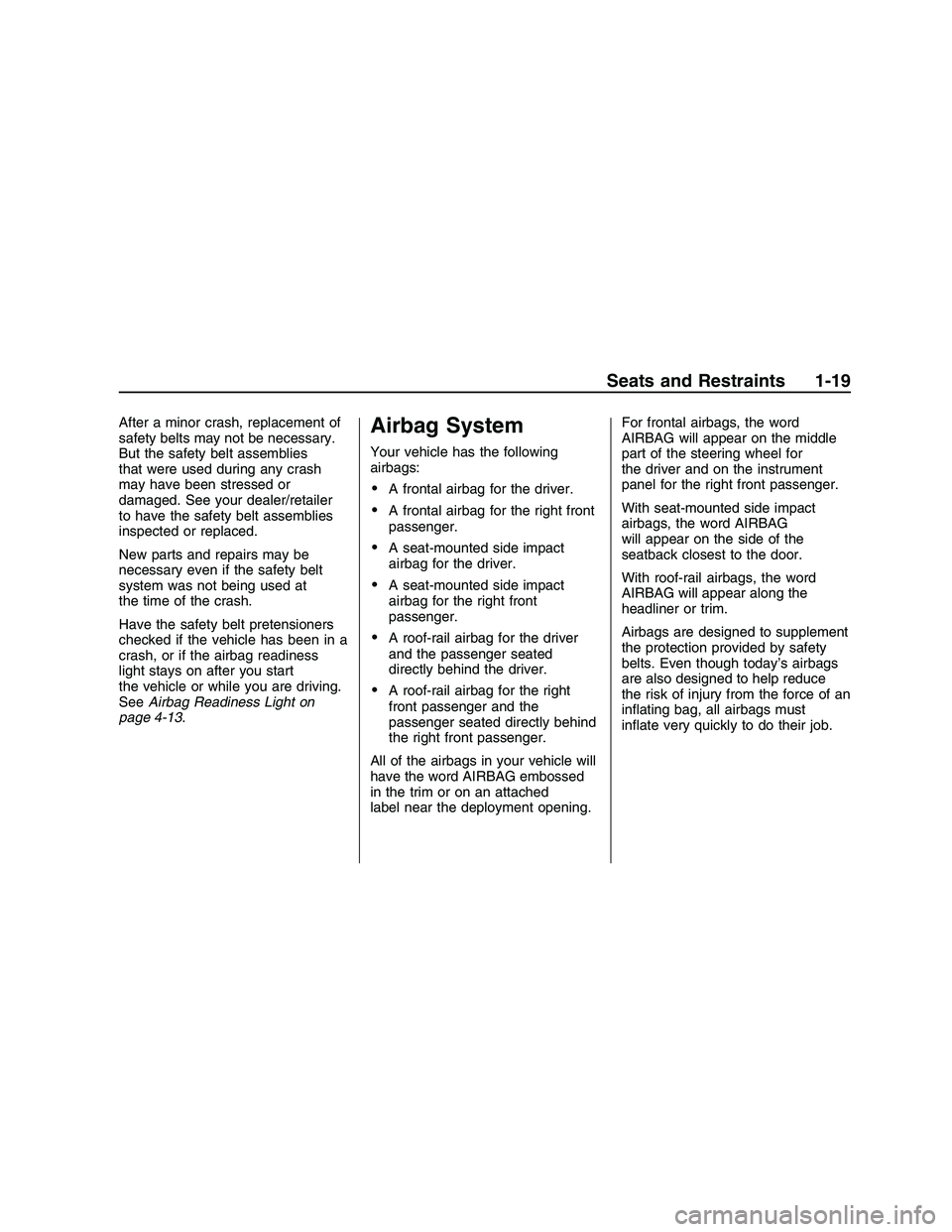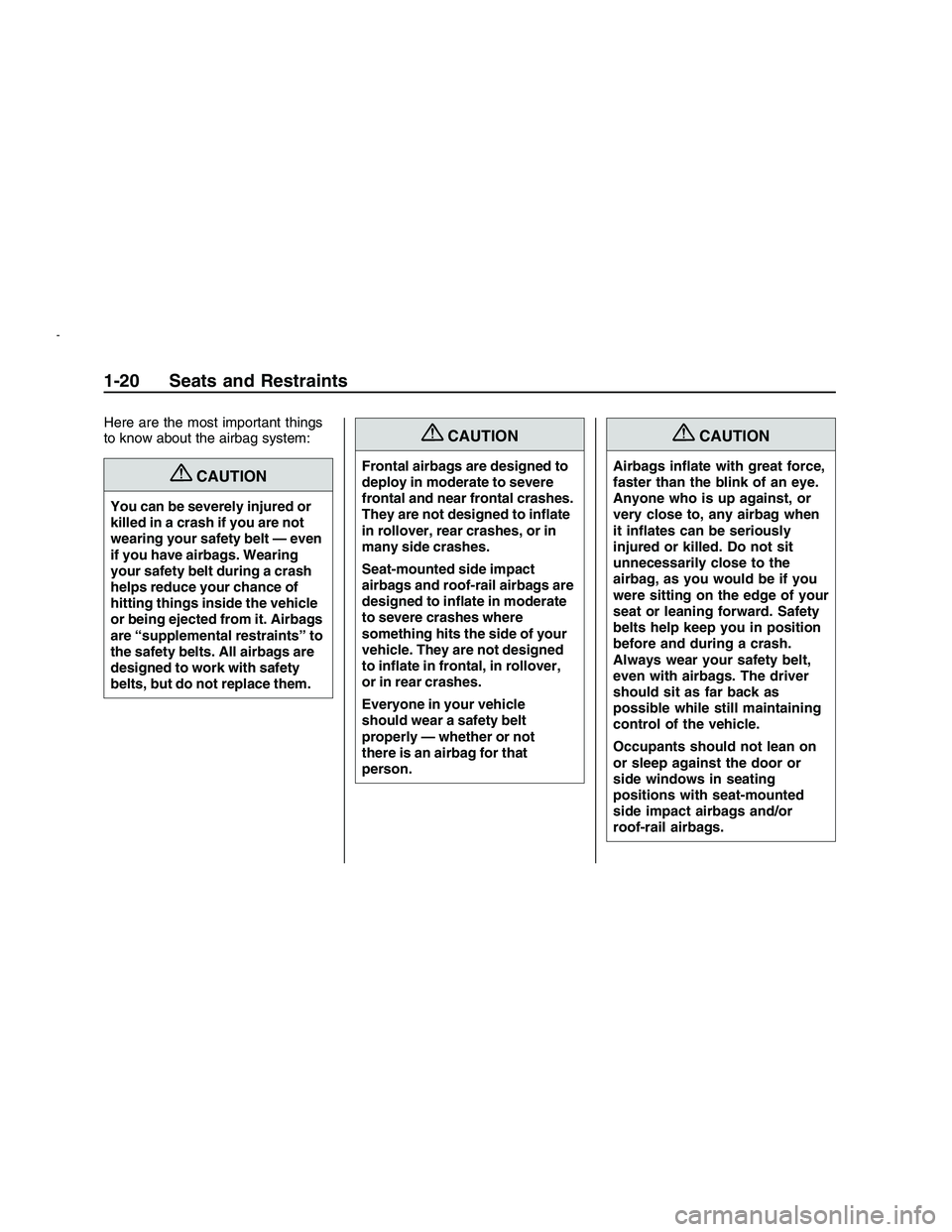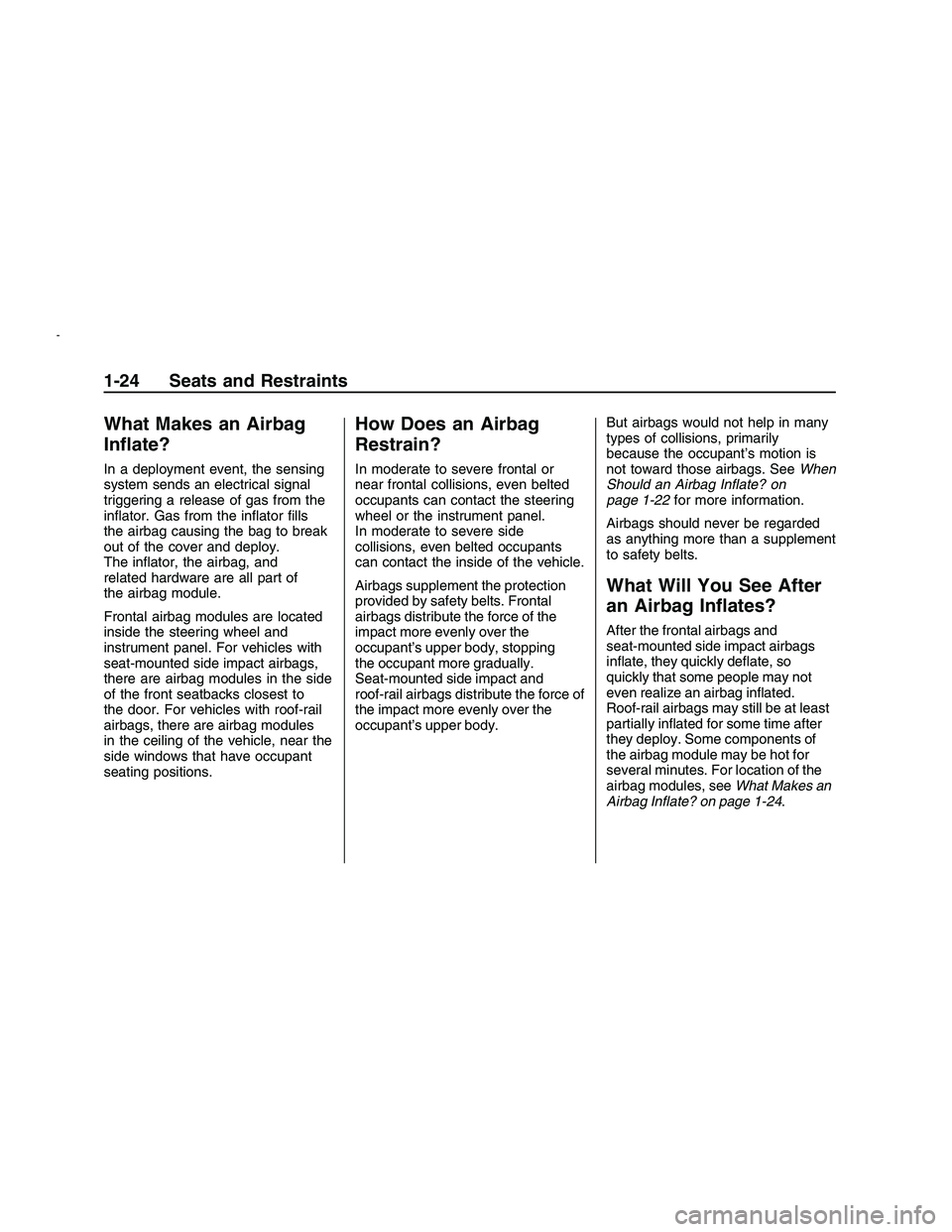2008 PONTIAC G8 roof
[x] Cancel search: roofPage 1 of 334

Seats and Restraints......... 1-1
Front Seats
.................... 1-2
Rear Seats
.................... 1-5
Safety Belts
................... 1-5
Airbag System
..............1-19
Child Restraints
.............1-32
Keys, Doors and
Windows............................ 2-1
Keys
............................. 2-2
Doors and Locks
............ 2-8
Theft-Deterrent
Systems
...................2-11
Windows
......................2-14
Mirrors
.........................2-16
Sunroof
........................2-18
Storage.............................. 3-1
Storage
......................... 3-1
Instruments and
Controls............................. 4-1
Instrument Panel
Overview
.................... 4-2
Warning Lights, Gages,
and Indicators
............4-10Driver Information
Center (DIC)
.............4-23
OnStar
®System
............4-36
Lighting............................. 5-1
Lighting
......................... 5-1
Infotainment...................... 6-1
Audio System(s)
............. 6-1
Climate Controls............... 7-1
Climate Controls
............. 7-1
Driving and Operating....... 8-1
Starting and Operating Your
Vehicle
....................... 8-2
Driving Your Vehicle
......8-13
Fuel
............................8-32
Vehicle Service
and Care............................ 9-1
Service
.......................... 9-2
Owner Checks
................ 9-5
Headlamp Aiming
..........9-27
Bulb Replacement
.........9-29Electrical System
...........9-32
Tires
...........................9-39
Tire Changing
...............9-62
Jump Starting
...............9-80
Towing
........................9-84
Appearance Care
..........9-91
Technical Data.................10-1
Vehicle Identi�cation
. . . . . . 10-1
Capacities and
Speci�cations
............10-2
Service and
Maintenance.....................11-1
Service and
Maintenance
..............11-1
Customer Information. . . . . . 12-1
Customer Information
. . . . . 12-1
Reporting Safety
Defects
...................12-14
Vehicle Data Recording
and Privacy
.............12-16
Index................................... i-1
2008 Pontiac G8 Owner ManualM
2008 - Pontiac G8 Owner Manual
Page 23 of 334

After a minor crash, replacement of
safety belts may not be necessary.
But the safety belt assemblies
that were used during any crash
may have been stressed or
damaged. See your dealer/retailer
to have the safety belt assemblies
inspected or replaced.
New parts and repairs may be
necessary even if the safety belt
system was not being used at
the time of the crash.
Have the safety belt pretensioners
checked if the vehicle has been in a
crash, or if the airbag readiness
light stays on after you start
the vehicle or while you are driving.
SeeAirbag Readiness Light on
page 4-13.Airbag System
Your vehicle has the following
airbags:
A frontal airbag for the driver.
A frontal airbag for the right front
passenger.
A seat-mounted side impact
airbag for the driver.
A seat-mounted side impact
airbag for the right front
passenger.
A roof-rail airbag for the driver
and the passenger seated
directly behind the driver.
A roof-rail airbag for the right
front passenger and the
passenger seated directly behind
the right front passenger.
All of the airbags in your vehicle will
have the word AIRBAG embossed
in the trim or on an attached
label near the deployment opening.For frontal airbags, the word
AIRBAG will appear on the middle
part of the steering wheel for
the driver and on the instrument
panel for the right front passenger.
With seat-mounted side impact
airbags, the word AIRBAG
will appear on the side of the
seatback closest to the door.
With roof-rail airbags, the word
AIRBAG will appear along the
headliner or trim.
Airbags are designed to supplement
the protection provided by safety
belts. Even though today’s airbags
are also designed to help reduce
the risk of injury from the force of an
in�ating bag, all airbags must
in�ate very quickly to do their job.
Seats and Restraints 1-19
2008 - Pontiac G8 Owner Manual
Page 24 of 334

Here are the most important things
to know about the airbag system:
{CAUTION
You can be severely injured or
killed in a crash if you are not
wearing your safety belt — even
if you have airbags. Wearing
your safety belt during a crash
helps reduce your chance of
hitting things inside the vehicle
or being ejected from it. Airbags
are “supplemental restraints” to
the safety belts. All airbags are
designed to work with safety
belts, but do not replace them.
{CAUTION
Frontal airbags are designed to
deploy in moderate to severe
frontal and near frontal crashes.
They are not designed to in�ate
in rollover, rear crashes, or in
many side crashes.
Seat-mounted side impact
airbags and roof-rail airbags are
designed to in�ate in moderate
to severe crashes where
something hits the side of your
vehicle. They are not designed
to in�ate in frontal, in rollover,
or in rear crashes.
Everyone in your vehicle
should wear a safety belt
properly — whether or not
there is an airbag for that
person.
{CAUTION
Airbags in�ate with great force,
faster than the blink of an eye.
Anyone who is up against, or
very close to, any airbag when
it in�ates can be seriously
injured or killed. Do not sit
unnecessarily close to the
airbag, as you would be if you
were sitting on the edge of your
seat or leaning forward. Safety
belts help keep you in position
before and during a crash.
Always wear your safety belt,
even with airbags. The driver
should sit as far back as
possible while still maintaining
control of the vehicle.
Occupants should not lean on
or sleep against the door or
side windows in seating
positions with seat-mounted
side impact airbags and/or
roof-rail airbags.
1-20 Seats and Restraints
2008 - Pontiac G8 Owner Manual
Page 26 of 334

The roof-rail airbags for the driver,
right front passenger, and second
row outboard passengers are in the
ceiling above the side windows.
{CAUTION
If something is between an
occupant and an airbag, the
airbag might not in�ate
properly or it might force the
object into that person causing
severe injury or even death.
The path of an in�ating airbag
must be kept clear. Do not put
anything between an occupant
and an airbag, and do not
attach or put anything on the
steering wheel hub or on or
near any other airbag covering.
(Continued)
CAUTION (Continued)
Do not use seat accessories
that block the in�ation path of a
seat-mounted side impact
airbag.
Never secure anything to the
roof of a vehicle with roof-rail
airbags by routing a rope or tie
down through any door or
window opening. If you do, the
path of an in�ating roof-rail
airbag will be blocked.
When Should an Airbag
In�ate?
Frontal airbags are designed to
in�ate in moderate to severe frontal
or near-frontal crashes to help
reduce the potential for severe
injuries mainly to the driver’s or right
front passenger’s head and chest.
However, they are only designed toin�ate if the impact exceeds a
predetermined deployment
threshold. Deployment thresholds
are used to predict how severe
a crash is likely to be in time for the
airbags to in�ate and help restrain
the occupants.
Whether the frontal airbags will or
should deploy is not based on
how fast your vehicle is traveling.
It depends largely on what you
hit, the direction of the impact, and
how quickly your vehicle slows
down.
Frontal airbags may in�ate at
different crash speeds. For example:
If the vehicle hits a stationary
object, the airbags could
in�ate at a different crash speed
than if the vehicle hits a
moving object.
If the vehicle hits an object that
deforms, the airbags could
in�ate at a different crash speed
than if the vehicle hits an
object that does not deform.
1-22 Seats and Restraints
2008 - Pontiac G8 Owner Manual
Page 27 of 334

If the vehicle hits a narrow object
(like a pole), the airbags could
in�ate at a different crash speed
than if the vehicle hits a wide
object (like a wall).
If the vehicle goes into an object
at an angle, the airbags could
in�ate at a different crash speed
than if the vehicle goes straight
into the object.
Thresholds can also vary with
speci�c vehicle design.
Frontal airbags are not intended to
in�ate during vehicle rollovers,
rear impacts, or in many side
impacts.
In addition, the vehicle has
dual-stage frontal airbags.
Dual-stage airbags adjust the
restraint according to crash severity.
The vehicle has electronic frontalsensors, which help the sensing
system distinguish between a
moderate frontal impact and a more
severe frontal impact. For moderate
frontal impacts, dual-stage airbags
in�ate at a level less than full
deployment. For more severe frontal
impacts, full deployment occurs.
The vehicle has seat-mounted side
impact and roof-rail airbags. See
Airbag System on page 1-19.
Seat-mounted side impact and
roof-rail airbags are intended
to in�ate in moderate to severe side
crashes. Seat-mounted side
impact and roof-rail airbags will
in�ate if the crash severity is above
the system’s designed threshold
level. The threshold level can vary
with speci�c vehicle design.
Seat-mounted side impact and
roof-rail airbags are not intended to
in�ate in frontal impacts, near-frontal
impacts, rollovers, or rear impacts.A seat-mounted side impact airbag
is intended to deploy on the side
of the vehicle that is struck.
A roof-rail airbag is intended to
deploy on the side of the vehicle
that is struck.
In any particular crash, no one can
say whether an airbag should
have in�ated simply because of the
damage to a vehicle or because
of what the repair costs were.
For frontal airbags, in�ation is
determined by what the vehicle hits,
the angle of the impact, and how
quickly the vehicle slows down.
For seat-mounted side impact and
roof-rail airbags, deployment is
determined by the location
and severity of the side impact.
Seats and Restraints 1-23
2008 - Pontiac G8 Owner Manual
Page 28 of 334

What Makes an Airbag
In�ate?
In a deployment event, the sensing
system sends an electrical signal
triggering a release of gas from the
in�ator. Gas from the in�ator �lls
the airbag causing the bag to break
out of the cover and deploy.
The in�ator, the airbag, and
related hardware are all part of
the airbag module.
Frontal airbag modules are located
inside the steering wheel and
instrument panel. For vehicles with
seat-mounted side impact airbags,
there are airbag modules in the side
of the front seatbacks closest to
the door. For vehicles with roof-rail
airbags, there are airbag modules
in the ceiling of the vehicle, near the
side windows that have occupant
seating positions.
How Does an Airbag
Restrain?
In moderate to severe frontal or
near frontal collisions, even belted
occupants can contact the steering
wheel or the instrument panel.
In moderate to severe side
collisions, even belted occupants
can contact the inside of the vehicle.
Airbags supplement the protection
provided by safety belts. Frontal
airbags distribute the force of the
impact more evenly over the
occupant’s upper body, stopping
the occupant more gradually.
Seat-mounted side impact and
roof-rail airbags distribute the force of
the impact more evenly over the
occupant’s upper body.But airbags would not help in many
types of collisions, primarily
because the occupant’s motion is
not toward those airbags. SeeWhen
Should an Airbag Inflate? on
page 1-22for more information.
Airbags should never be regarded
as anything more than a supplement
to safety belts.
What Will You See After
an Airbag In�ates?
After the frontal airbags and
seat-mounted side impact airbags
in�ate, they quickly de�ate, so
quickly that some people may not
even realize an airbag in�ated.
Roof-rail airbags may still be at least
partially in�ated for some time after
they deploy. Some components of
the airbag module may be hot for
several minutes. For location of the
airbag modules, seeWhat Makes an
Airbag Inflate? on page 1-24.
1-24 Seats and Restraints
2008 - Pontiac G8 Owner Manual
Page 34 of 334

Servicing Your
Airbag-Equipped Vehicle
Airbags affect how your vehicle
should be serviced. There are parts
of the airbag system in several
places around your vehicle. Your
dealer/retailer and the service
manual have information about
servicing your vehicle and the airbag
system. To purchase a service
manual, seeService Publications
Ordering Information on page 12-15.
{CAUTION
For up to 10 seconds after the
ignition is turned off and the
battery is disconnected, an
airbag can still in�ate during
improper service. You can be
injured if you are close to an
airbag when it in�ates. Avoid
yellow connectors. They are
probably part of the airbag
system. Be sure to follow
proper service procedures, and
make sure the person
performing work for you is
quali�ed to do so.
Adding Equipment to
Your Airbag-Equipped
Vehicle
Q:Is there anything I might add
to or change about the
vehicle that could keep the
airbags from working
properly?
A:Yes. If you add things that
change the vehicle’s frame,
bumper system, height, front end
or side sheet metal, they may
keep the airbag system from
working properly. Changing or
moving any parts of the front
seats, safety belts, the airbag
sensing and diagnostic module,
steering wheel, instrument
panel, roof-rail airbag modules,
the inside rearview mirror, ceiling
headliner or pillar garnish trim,
front sensors, or airbag wiring can
affect the operation of the airbag
system.
1-30 Seats and Restraints
2008 - Pontiac G8 Owner Manual
Page 55 of 334

Keys, Doors and
Windows
Keys
Keys...................................2-2
Remote Keyless Entry
(RKE) System...................2-3
Remote Keyless Entry
(RKE) System Operation. . .2-4
Remote Vehicle Start..........2-6
Doors and Locks
Door Locks.........................2-8
Power Door Locks..............2-9
Rear Door Security Locks. . .2-9
Trunk................................2-10
Theft-Deterrent Systems
Theft-Deterrent Systems. . . .2-11
Immobilizer.......................2-11
Immobilizer Operation.......2-12
Content Theft-Deterrent.....2-13
Windows
Windows...........................2-14
Power Windows................2-15
Sun Visors........................2-15
Mirrors
Manual Rearview Mirror. . . .2-16
Compass..........................2-16
Outside Power Mirror(s). . . .2-17
Outside Convex Mirror......2-18
Sunroof
Sunroof.............................2-18
Keys, Doors and Windows 2-1
2008 - Pontiac G8 Owner Manual